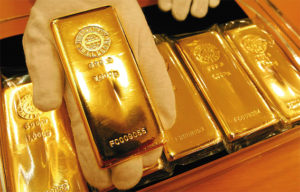 Gold hovered near the $1 200 mark on Wednesday as investors weighed global stimulus expansion versus prospects of tightening monetary policy in the US, eyeing a strong US dollar and the outcome of a Swiss referendum on central bank gold holdings.
Gold hovered near the $1 200 mark on Wednesday as investors weighed global stimulus expansion versus prospects of tightening monetary policy in the US, eyeing a strong US dollar and the outcome of a Swiss referendum on central bank gold holdings.
Comex gold for delivery in February was up 0.14% at $1 199.5 per troy ounce at 7:49 GMT, having shifted in a daily range of $1 201.6-$1 198.0 an ounce. The precious metal gained 0.10% on Tuesday to $1 197.8.
Prices held in a tight range during the week, lacking distinct direction despite key economic US data, ahead of the Thanksgiving Day holidays and the Swiss referendum on Sunday.
Gold rose to a three-week high on Friday after the Peoples Bank of China surprisingly cut interest rates for the first time since 2012 in an attempt to jump-start the cooling Chinese economy. The PBOCs move came shortly after the ECB pledged to continue battling dangerously low inflation, having already cut rates, bought covered bonds and asset-backed securities and offered long-term loans to banks, while the Bank of Japan also expanded its stimulus in October.
However, although monetary easing by major central banks lifts gold, which is used as a hedge against inflation, the precious metals movement remained mainly tied to the US dollar, particularly to shifts in the Federal Reserves monetary stance.
Policy makers wrapped up the central banks unprecedented Quantitative Easing program at FOMCs October 28-29 meeting and despite sounding caution of inflation still failing to reach a set target, committee members expressed optimism about the US economy’s recovery.
Lv Jie, an analyst at Cinda Futures Co., said cited by Bloomerg: “We expect the divergence in monetary policies between the U.S. and other economies to be sustained, keeping the dollar bullish and weighing on gold.”
The US dollar index fell for a second day on Tuesday, but remained in proximity to a recent 4-1/2-year high. The December contract closed 0.28% lower at 87.962 yesterday, having ranged between 88.400, close to Mondays 4-1/2-year high of 88.515, and 87.870 during the day. The contract was unchanged at 87.960 at 7:49 GMT on Wednesday.
The dollar eased after the Conference Board reported an unexpected drop in US consumer confidence in November, reflecting a drop in sentiment among Americans about the economy and labor market. The corresponding index slid to 88.7 from 94.1 in October, defying projections for a jump to 95.9.
On the bright side, the US Department of Commerce revised up its Q3 GDP growth measure to an annualized 3.9%, up from initially estimated at 3.5%. This, combined with the previous quarters 4.6% jump, marked the fastest back-to-back economic growth since late 2003.
Further cues from the dollar were expected today as the US Census Bureau reports on October durable goods orders at 13:30 GMT, while the Labor Department releases its weekly Initial Jobless Claims data. Later in the day are due the November Thomson Reuters/University of Michigan consumer sentiment index, while the Commerce Department reports on sales of newly-built homes in October and the National Association of Realtors will release its Pending Home Sales data.
Swiss referendum
Investors also avoided entering big positions ahead of Sundays referendum in Switzerland on central bank gold reserves. An opinion poll showed that support for a proposal to change the Swiss National Bank’s gold policy fell to 38% in November from 44% in October, with 47% of voters opposing the measure, while 15% were undecided.
Under the proposal, the central bank would be banned from selling its gold reserves and should back at least 20% of its assets with the metal, up from 7.8% in October. If the vote were to be positive, this would drive physical demand for the precious metal, boosting prices up.
The impact of a “yes” vote could push gold up by as much as $50, while a “no” vote, albeit the most probable outcome, would reinforce the markets bearish stance.
Reflecting persisting downbeat sentiment for the yellow metal, assets in the SPDR Gold Trust remained unchanged for a fourth day at 720.91 tons, an inch above November 13ths 720.62 tons, which was the lowest since September 2008.
Pivot points
According to Binary Tribune’s daily analysis, February gold’s central pivot point on the Comex stands at $1 196.9. If the contract breaks its first resistance level at $1 203.9, next barrier will be at $1 209.9. In case the second key resistance is broken, the precious metal may attempt to advance to $1 216.9.
If the contract manages to breach the S1 level at $1 190.9, it will next see support at $1 183.9. With this second key support broken, movement to the downside may extend to $1 177.9.





